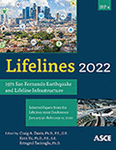Deterministic Optimization Model for Budget Allocation to Seismic Risk Mitigation for Water Distribution System
Publication: Lifelines 2022
ABSTRACT
This paper presents a deterministic optimization model that can be utilized for budget allocation to implement retrofitting measures for steel and concrete water pipelines. This model can be used by decision-makers to develop budget allocation strategies and to determine which strengthening and retrofit methods are the most practical and economical to be used considering a predefined set of limitations and criteria. The deterministic model determines the optimal retrofit measures based on minimizing the pipe retrofit costs, post-earthquake replacement costs, and especially large seismic losses. The main constraints considered for this model are mitigation budget constraint, mitigation strategy constraint, and risk of especially large loss constraint. A case study is performed for a pilot area per the return of certain earthquake to demonstrate the application and practical aspects of the model. Pipeline exposure database, built environment occupancy type, pipeline vulnerability functions, and regional seismic hazard characteristics are used to calculate a probabilistic seismic risk for the pilot area. The results provide the variation of retrofit costs for pipelines in the pilot area based on their geographical location and the selected strengthening measures.
Get full access to this article
View all available purchase options and get full access to this chapter.
REFERENCES
ANSS: San Fernando 1971 (accessed 2018-05-05).
USGS. (2009). PAGER-CAT Earthquake Catalog, Version 2008_06.1, US Geological Survey.
Reich, K. (1996). “’71 Valley Quake a Brush With Catastrophe”. Archived from the original on October 15, 2012. Retrieved May 20, 2013.
Zarghamee, M. S., and Engindeniz, M. (2014). “CFRP renewal of PCCP–An overview. Paper Presented at the ASCE Pipelines 2014 Conference”. Retrieved October 30, 2015 available at: http://ascelibrary.org/doi/abs/10.1061/9780784413692.084.
Peyghaleh, E. (2014). Optimization Modeling for Financial Resource Allocation towards Seismic Risk Reduction, Ph.D. Dissertation K.N. Toosi University of Technology, Tehran, Iran.
FEMA. (2004). Using HAZUS-MH for risk assessment (FEMA 433)., Washington, DC, United States, 224 pp.
O’Rourke, M. J., and Ayala, G. (1993). “Pipeline Damage due to Wave Propagation” Journal of Geotechnical Engineering, ASCE Vol 119, No.9, Sept. 1993.
OpenQuake. (2017). https://platform.openquake.org/explore/.
Dodo, A., Xu, N., Davidson, R., and Nozick, L. (2005). “Optimizing regional earthquake mitigation investment strategies”. Earthq Spectra 21(2):305–327.
Peyghaleh, E., and Alkhrdaji, T. (2019). “Resource Allocation Model Toward Seismic Water Pipeline Risk Mitigation Measures”, ; https://doi.org/10.1115/PVP2019-93057.
Xu, N., Davidson, R., Nozick, L., and Dodo, A. (2007). “The risk-return tradeoff in optimizing regional earthquake mitigation investment”. Struct Infrastruct Eng 3(2):133–146.
Peyghaleh, E. (2014). “Resource allocation for regional earthquake risk mitigation considering equity, using two stage stochastic and deterministic programming”, Journal of emergency management, volume 4, Page 77-94.
Zolfaghari, M. R., and Peyghaleh, E. (2015). Implementation of equity in resource allocation for regional earthquake risk mitigation using two‐stage stochastic programming, Risk Analysis, February 2015.
CPLEX Optimizer. (2013). “High-performance mathematical programming solver for linear programming, mixed integer programming, and quadratic programming”,. Copyright IBM Corporation and other(s) 1987, 2011.
FEMA. (1999). “HAZUS earthquake loss estimation methodology”. FEMA, Washington, D.C.
Ndah, T. (2016). The Buried Pipeline Replacement Era: A Cost effectiveness Analysis of Pipeline Replacement Strategies for the Santa Clara Valley Water District, Master’s Theses and Graduate Research, San Jose State University, Spring 2016.
USGS OFR 03-214. (2003). Earthquake Probabilities in the San Francisco Bay Region: 2002–2031, by Working Group on California Earthquake Probabilities. Available at: https://pubs.usgs.gov/of/2003/of03-214/OFR-03-214_FullText.pdf.
GEM. (2012b). OpenQuake book. Available in http://www.globalquakemodel.org/openquake/support/documentation/.
Campbell, K. W., and Bozorgnia, Y. (2014). “NGA-West2 Ground Motion Model for the Average Horizontal Components of PGA, PGV, and 5 % Damped Linear Acceleration Response Spectra” Earthquake Spectra, Vol 30, No 3, pages 1087–1115.
G&E (Engineering Systems, Inc.). (1994). “NIBS Earthquake Loss Estimation Methods, ”, May 1994.
FEMA. (2009). NEHRP Recommended Seismic Provisions for New Buildings and Other Structures, FEMA P-750, Washington, D.C.
FEMA. (2017). Hazus® Estimated Annualized Earthquake Losses for the United State”s, FEMA P-366/ April 2017.
McPhillips, D. F., Herrick, J. A., Ahdi, S., Yong, A. K., and Haefner, S. (2020). Updated Compilation of VS30 Data for the United States: U.S. Geological Survey data release, https://doi.org/10.5066/P9H5QEAC.
SHMP. (2018). California state hazard mitigation plan, September 2018, Chapter 6 – Earthquakes and geologic hazards: Risks and mitigation, https://www.caloes.ca.gov/cal-oes-divisions/hazard-mitigation/hazard-mitigation-planning/state-hazard-mitigation-plan.
LADWP. (2019). LADWP Water Infrastructure Plan, ladwp.com, Rev 11/19.
Information & Authors
Information
Published In
History
Published online: Nov 16, 2022
Authors
Metrics & Citations
Metrics
Citations
Download citation
If you have the appropriate software installed, you can download article citation data to the citation manager of your choice. Simply select your manager software from the list below and click Download.
